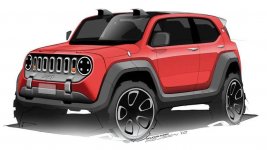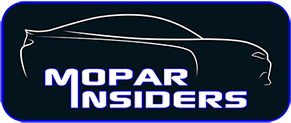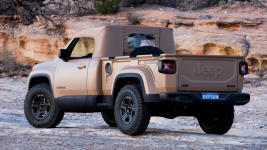It might work in Europe and Asia. It might be possible to offer 4 wheel drive as an option by using an electric motor to drive the rear wheels as in the Pacifica. In Australia the Renegade has been taken off the market because the Compass stole too many of its sales. Something smaller than Renegade may work. Small Suzukis have steady sales here.
The Chrysler Pacifica’s AWD system – the first available in a Chrysler minivan since 2004 – uses mechanical and electronic technology proven durable and capable on FCA vehicles. In addition, the system was put through its paces, with more than 1 million customer-driven-equivalent miles of testing prior to introduction.
Key mechanical components of the Chrysler Pacifica AWD system include:
- Power Transfer Unit (PTU): Splits torque from the nine-speed automatic transmission and routes it to the rear drive module
- Three-piece Drive Shaft: Connects the PTU and the rear drive module. Even with the additional driveline components, the Chrysler Pacifica AWD retains its second-row Stow ‘n Go seating storage
- Rear Drive Module: Houses electronically controlled wet clutch that manages torque to rear wheels; second-generation one-speed drive module optimized for weight and low-speed drag torque reduction
Other mechanical changes resulting in improved driving dynamics include the addition of a rear sway bar and revised tuning for the front and rear suspension. Ride height is increased 0.78 inches (20 millimeters).
Pacifica’s seamless, fully automatic AWD system is the only one in the segment capable of transferring 100 percent of the available engine torque to the rear wheels, or whichever wheels have more available traction. The Pacifica AWD system, the most capable AWD in the class, is also able to sense and stop the drive shaft from spinning when AWD is not required, a class-exclusive feature in the segment that improves efficiency.
The AWD system also employs a brake-lock differential system to help enhance traction, with fully automatic torque distribution between each wheel. If one wheel on an axle loses traction, the system applies the brake to the low-traction wheel, redirecting torque through the differential to the wheel with more traction. The 18-inch brake package for AWD features larger vented front and solid rear rotors and calipers with more capacity.
The AWD system engages automatically, based on a variety of sensor inputs that signal when enhanced traction is beneficial. For best traction performance, AWD is engaged when the Chrysler Pacifica begins to accelerate from a standing stop. Other inputs that signal AWD engagement include:
- Cold exterior temperature
- Use of windshield wipers
- Slip detected at the front wheels
- Heavy acceleration at certain vehicle speeds, such as overtaking during passing
- Electronic stability control activation
- Abrupt steering or sudden throttle inputs
- Rough road conditions/grades
When the Chrysler Pacifica’s drivetrain detects that AWD is not needed, it disconnects the PTU and rear drive module automatically to stop the drive shaft from spinning, reducing driveline drag and improving efficiency.


 moparinsiders.com
moparinsiders.com

